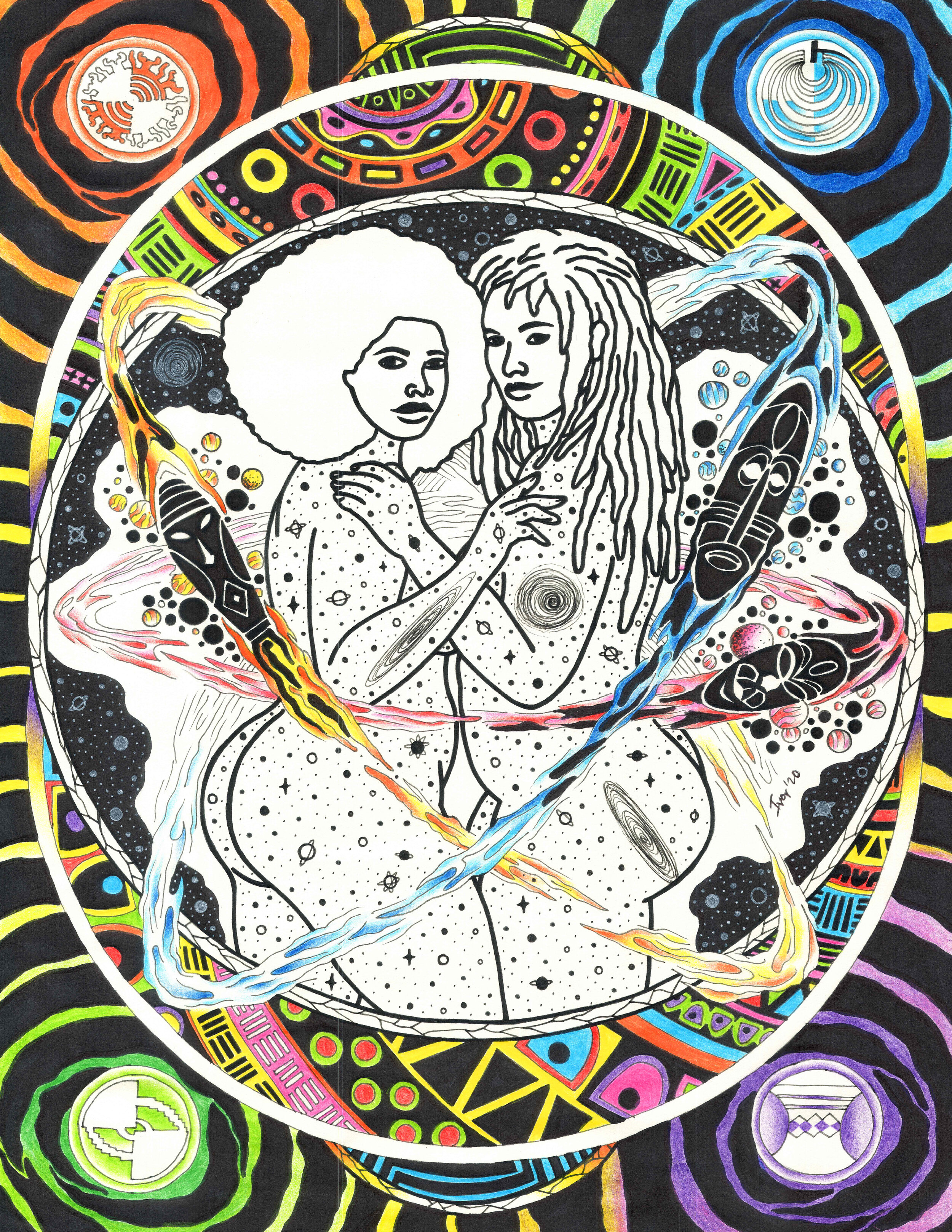Free at Last
by Ivor Samuel Mubiru
2021, Watercolour paint, marker, pen, and pencil, 11.7” x 16.5”
An illustration of abstract dancing figures within a galaxy.
“This piece simply represents the beauty in dance in our Ugandan culture. Dancing has been used in so many different tribes and societies during different ceremonies. This could be birth, death, rain, prayer, entertainment for traditional chiefs, marriage ceremonies etc. Dance has become part of our stories as much as language and it’s something we are taught in Ugandan primary and secondary schools growing up, in both stories and performance – Us all freely and happily dancing as the birds fly around.”
Malayika
2021, Watercolour paint, marker, pen, and pencil, 11.7” x 16.5”
An illustration of a meditative figure in the sea.
“A lot of stories told to us revolve around traditional clans and cultures in the African (Ugandan) societies and history. In this piece, the Malayika (an angel) wearing traditional bark cloth prays for peace upon the Baganda Mmamba (lungfish) clan. “Abaana n’abazukulu omuziro mmamba”—the children and grandchildren of the Mmaba clan. It is important to note that I am also of the Mmamba clan.”
He Has Escaped
2021, Watercolour paint, pastel, marker, pen, and pencil, 11.7” x 16.5”
An illustration of a figure escaping a maze towards a tunnel in the sky.
“This piece represents both the stories about traditional gods and goddesses as well as the hand of creation coming together. Typically, when growing up, often the traditional gods are represented as evil spirits and demonic mermaids. This is because of colonization stories and missionary work that introduced new religions in the time of our grandparents. The piece therefore paints them in a different light – two traditional African goddesses coming together to create this portal to the hand of creation so that the man can escape this trap. It is a different take, almost rebellion, to the way our traditions have been put down, and rather proposes the idea of integration to create peace in one’s self – acceptance of change but embracing the past.”
Study of an Atom
2020, Colour pencils, pens, markers, 11.7” x 16.5”
An illustration of two female figures embracing each other with an abstract background.
“This is a representation of how money and wealth has gotten into the roots (the atoms per say) of the traditional African societies. The traditional masks around the universe formed as two African women represents the idea of an atom, the things we are made up of. The symbols are typically found on the notes of Ugandan currency. They are represented hypnotically as a statement to our political systems and leaders due to corruption and how money has hypnotized and derailed a society that was once all about community and togetherness that our parent’s ‘growing up stories’ are all about.”
The Deep Dive
2020, Colour pencils, pens, markers, 11.7” x 16.5”
An illustration of a figure diving into the water, meeting their reflection in a round mirror.
“This is a response to the slave stories I was told while growing up. It is known that a lot of “black” people were transported on slave ships during the colonialization period. But opposed to the horror of jumping off ships to die instead of being slaves, this art piece depicts a black woman with her hair completely shaved off (starting a new) while freely diving into the same seas, the deep water, as she wears her slave chains as earrings instead. The red pill she wears is a statement representing the willingness to learn a potentially unsettling or life-changing truth as she dives – courageously moving forward, not backwards anymore.”
Ivor Samuel Mubiru is of Ugandan nationality and is an architect/freelance artist that is primarily self-taught. His themes revolve mostly around African traditions, culture, religion, politics, and science, etc.





